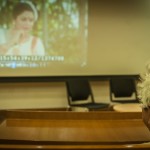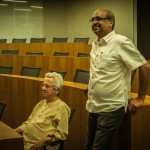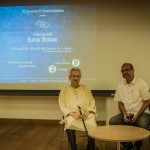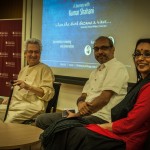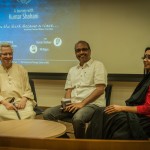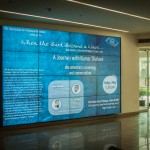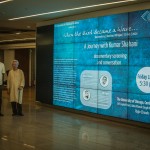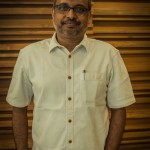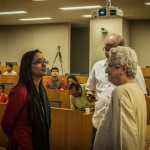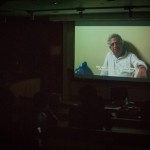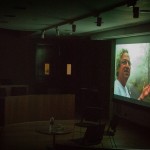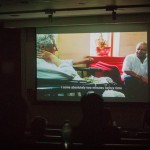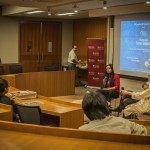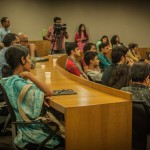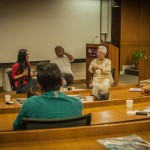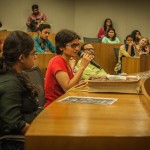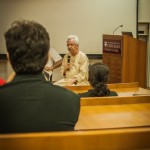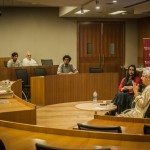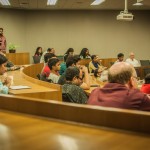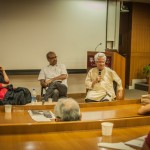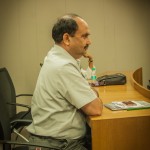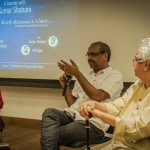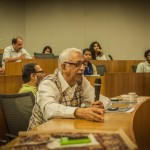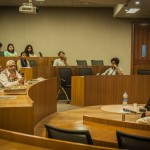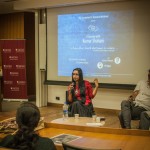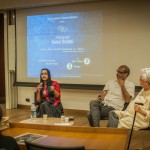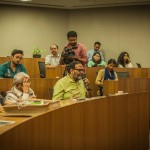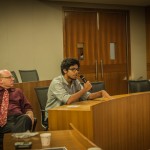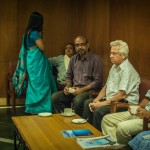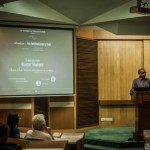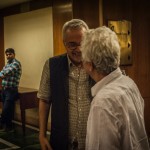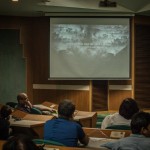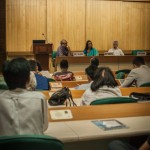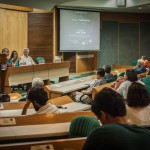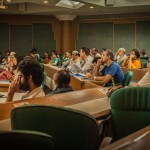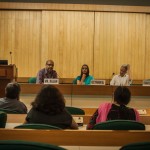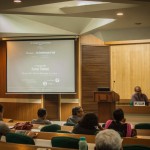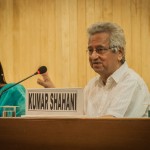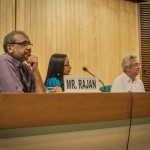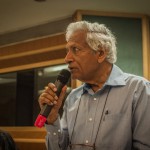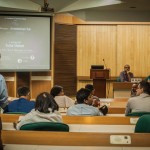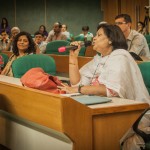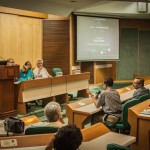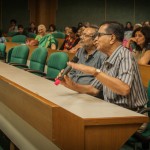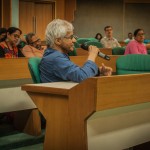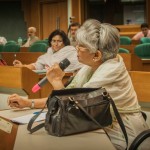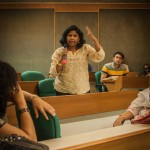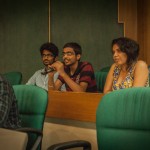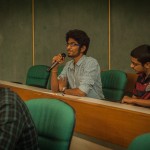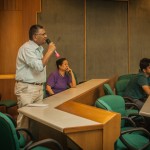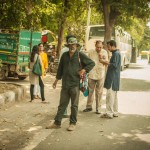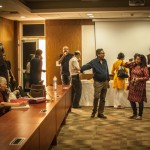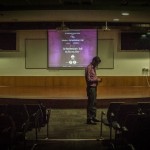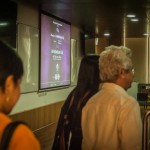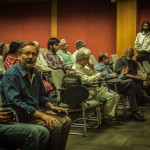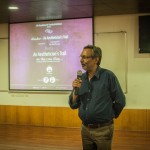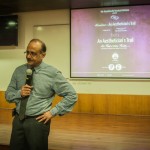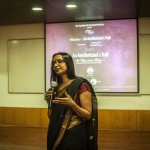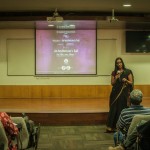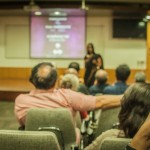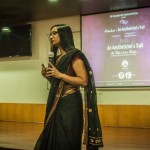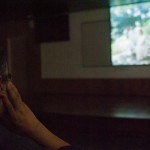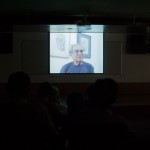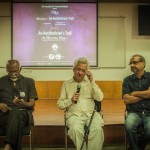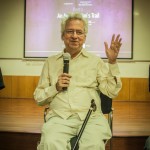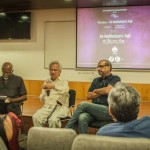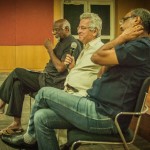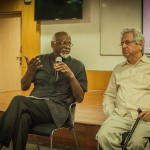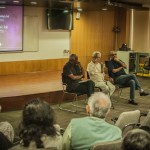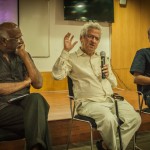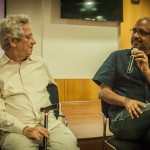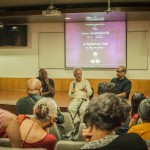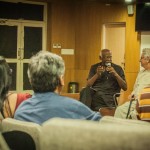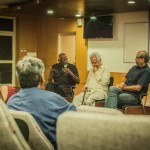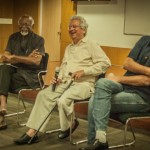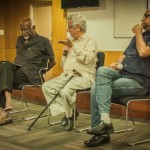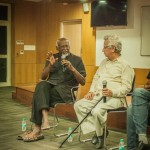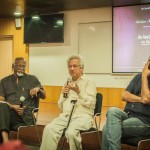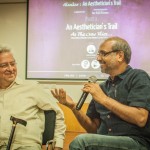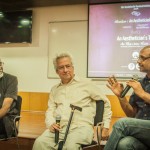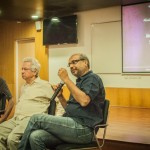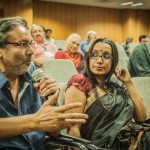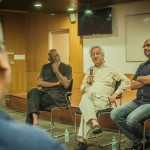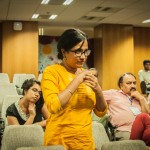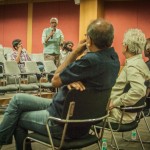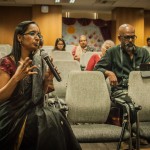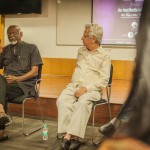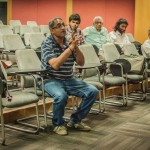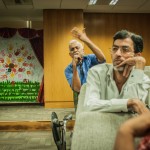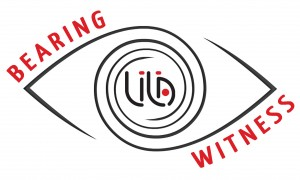
LILA Bearing Witness presents: A Journey with Kumar Shahani, three evenings celebrating the vision and the touch of legendary filmmaker Kumar Shahani. Organised in May 2015 at The University of Chicago, Center in Delhi, India Habitat Centre, and Shiv Nadar University, the three events comprised various screenings and conversations with Shahani, MR Rajan and Sadanand Menon.

© LILA Foundation
When the Bird Became a Wave…
A Journey with Kumar Shahani
documentary screening and conversation
Friday 1 May 2015
The University of Chicago, Center in Delhi
When The Bird Became a Wave…
Documentary | 72 min | 2014
Direction: MR Rajan
Script: V. Sasikumar
Digital Recording: Sunny Joseph
Edit: Vijeesh
Production: Cinematograph Kerala
“In many ways, Kerala is more than a home for me.” Intriguing words from Sindh-born legendary filmmaker Kumar Shahani, as he addresses a large audience in ‘God’s own country’. Like in his cinema, Shahani is, in life, bringing the imagined into the factual, the ideal in the realistic. MR Rajan’s When the Bird Became a Wave is a documentary that was not meant to be one, following the director of Maya Darpan through four years of repeated, passionate, perhaps obsessed travels back to Kerala.
Shahani before the camera, for once; breaking across the fictionality of stories with the immediate urges of reality. Prompted by Rajan, Shahani sings a hymn during a walk through a rainy forest road of inner Kerala. His inspiration: the subtle birdcalls, unnoticeable to many, but permanent connections with the world for the artist of imagination. Thus he goes, from Thrissur to Kozhikode, every bit of an encounter with a sound, a colour, a landscape triggering musings on the world that surrounds us. Rajan listens and records patiently, cutting across dozens of months of shooting to reveal the profound coherence of Shahani’s horizontal stare.
Communication comes across as violence. Shahani reflects on the dynamics of today’s inter-connected world, its movement from consumerist capitalism to being a military-industrial complex. Against this background, he defends the voice of resistance, of alternatives, indefatigably, facing a Malayali crowd in the documentary. It is the same passion he shows in Delhi, too, during the first screening of the film on 1 May 2015, at The University of Chicago, Center in Delhi.
The irreversible technologisation of the society remains a matter of contemplation for Shahani, and he insists equally on his worries and his hopes around the digital turn explored by cinema in the last decades. “People using the digital are not seeing its potential,” Shahani commented, “they are not allowing it to grow.” Kodak has stopped manufacturing celluloid films. “It is a great crisis, but one that can be turned around. With directors like MR Rajan, for instance.” This generation of filmmakers would face simultaneously three questions: how to meet the technological change and how to explore new aesthetics with it; how to perpetuate a concern for social change in the work of art; and how to face “an absolutely fascistic, worldwide political era.” “Even the greatest apologists of Capitalism,” Shahani added, “are today saying that something went terribly wrong.”
Facing these total threats, a central energy remains. “We are born to know. It is an instinct in us, as strong as the instinct to survive.” And this energy must be used to reinvigorate artistic creation and social response. Concluding the evening, Shahani commented: “we have to think of technology as a means to make possible new creations of signs.”
Anandi Mehra and Samuel Buchoul
❧

© LILA Foundation
Alankar : An Aesthetician’s Trail
4 and 5 May 2015
2 days of Film Screenings and Conversations
on the Aesthete’s Quest
in collaboration with

PART 1
When the Bird Became a Wave…
A Journey with Kumar Shahani
Monday 4 May 2015
Gulmohar Hall
India Habitat Centre
Delhi
When The Bird Became a Wave
Documentary | Direction: MR Rajan| 72 min | 2014
Andolan, Gamaka, Kan-Swar or Gitkari, Meend or Murki: the Alankars are multiple in types, and innumerable in practice. Each melody acquires its ornament, each note, its body. Alankar, a term for aesthetics in the Indian arts, is the adornment, the embellishment, the process that reveals the beautiful from within – the inherent beauty. Fascinating paradox: the Alankar is wilfully produced, coming above and beyond the theme, but it only enhances a beauty already proper to the art. Alankar permits beauty before the accompaniment – Alankar recalls how the inner light is still shining.
Today, it may seem that the ornamental, the touch that highlights the beautiful out of the material, is all around. Technology and arts education appear as the developments that permitted the opening of the appreciation and creation of the beautiful to a larger base. But means do not translate into ends automatically, and the aesthetician still follows his trail in this eternal quest. A quest that becomes in turn an intense learning process for the student, for the observer, for the audience. Alankar: An Aesthetician’s Trail – pleasure and necessity meet, creator and audience exchange on the means and fruits of the beautiful in today’s world. Alankar: for a new discourse on aesthetics.
The Alankar is a play of the in/out, of the deep inside and the out there. It is the creative tension of an outside gaze, distanced, dedicated to revealing beauty without being lured by its artifices. A careful and prolonged curving between the rough patches of our days, times of the gross, to return to the subtle, rediscovered with surprise as shelter for the most political, too. And, at times, words must come, over the frames, and after the art, to reclaim a world of possibility, to clarify intentions, to urge a sensibility back into the now. This second evening of screenings and discussions was the setting for a deep and prolonged exchange with Kumar Shahani, MR Rajan and the audience, moderated by Rizio Yohannan Raj.
“I became very sad on watching the movie. I still find it very painful,” commented MR Rajan about When the Bird Became a Wave. The intensity of the dark canvas painted by Kumar Shahani, combined with the naturalism of various scenes, showing Shahani in contrast to the norms of our times, almost on the verge of reducing him to silence. But, for the director, the movie remains painful for yet another reason: “It is very difficult to create, today. You are not allowed to make films. In India, it is almost impossible to make a film.” Vivan Sundaram, in the audience, enquired about the original dialogue of the informal character of the camera in Rajan’s piece, with the highly refined formality of Shahani’s cinema. “Would it be the same film if it was in 35 mm instead of digital?” “This is another question… I just could not afford it!” replied MR Rajan. “Maybe only the digital could have made such a film possible, with this level of speed and reactivity,” completed Namita Nayak. “By the time you put the 35 mm camera in place, the moment is gone…” Namita who is also a student of Shahani, and who is producing his latest film, reiterated her enthusiasm, amidst such challenging contexts: “But Shahani is not pessimistic at all! Can’t you see him happy like a laughing Buddha? He just has this optimistic, narcissistic attitude of sticking to the idea till the last bit. He never gives up.” With determination, great ideas become possible. “It takes a lot – more economic power, more energy – but greatness can be achieved. And that is why we continue working with him.”
“We are one of the most important countries today when it comes to film. The volume has been quite amazing, and I hope it remains that way,” noted Kumar Shahani. The discussion moved to the field of criticism. “But there is a general lack of respect for criticism.” Kumar Shahani, with reference to the abandoned project of an Institute for Advanced Studies in Aesthetics in Trissur, Kerala, explained: “Criticism depends on connecting disciplines with one another. To talk of film, to talk of performance, we must make the dialogue possible with, say, the natural sciences.” Leela Venkataraman highlighted another aspect contributing to this difficult cultural situation: “We are also a people that is not open to criticism. It just did not grow here. Our cultural commentaries are always about the ‘feel good’ factor.” Kumar Shahani, remembering ancient lessons, ended the evening with a note of wisdom: “It is a bit like those Shastras: it is not enough to quote them; you have to change them…”
Samuel Buchoul
❧
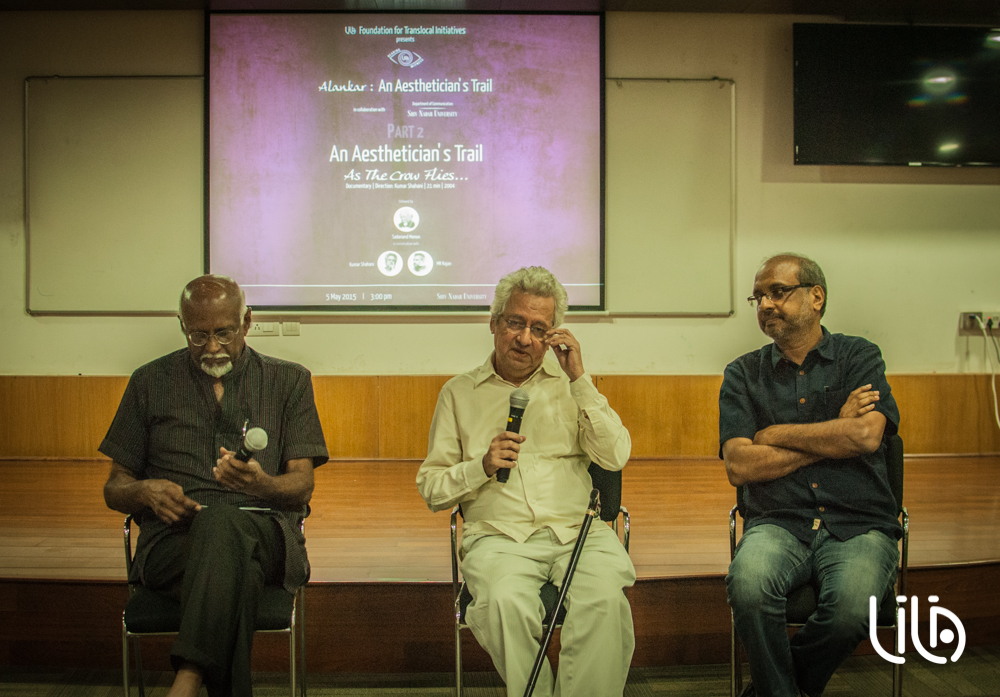
© LILA Foundation
PART 2
Kumar Shahani: An Aesthetician’s Trail
Tuesday 5 May 2015
Department of Communication
Shiv Nadar University
Dadri, UP
As The Crow Flies…
Documentary | Direction: Kumar Shahani | 21 min | 2004
Alankar, Part 2 – back to the ornament, the seeming outer crust, the appearance, the coincidences, the symbols that are always more than just hints. On the occasion of the screening of As The Crow Flies, the only digital film directed by Kumar Shahani, the collaboration of Shiv Nadar University was in many ways evocative. Education and technology are indeed bound to meet to create a setting making possible a serious and nuanced critique of the digital, creatively bypassing the pitfalls of a conservative, anti-technology discourse. This second part of Alankar, and sixth event under LILA’s banner Bearing Witness, also marked a full circle: Sadanand Menon joined the ongoing discussion between Kumar Shahani and MR Rajan. Bearing Witness was first conceptualised by Sadanand Menon and organised at SPACES, Chennai, a few years ago, before becoming one of the key banners of LILA Foundation. With Bearing Witness, we reclaim art as more than a passive participant, a silent voice – art bears witness to its times, to its spaces, to the often imperceptible rapports of artistic creations with our plural realities.
To initiate ideas and discussions for this afternoon with a first screening, Kumar Shahani selected a brief passage from his 1997 Char Adhyay, adapted from Rabindranath Tagore 1934 novel. “This is probably one of the most controversial things Tagore ever wrote. It has been abused by many political formations – from the British State against the Independence to freedom fighters themselves, to post-Independence governments and even left wing governments against Naxalites. And its latest abuse is probably my adaptation!”
Aesthetics of the digital and of the analog already entered the frame of discussions, as Sadanand Menon commented on the passage: “Just like in Maya Darpan, you explored an enunciation technique cutting the emotionality through a mannered, almost abstract speech. But if the movement is abstract, why did you choose the naturalistic setting of a garden?” “A film has to be at once non-theatrical and non-realistic, and the best way around it,” commented Shahani, “is to equip the contingencies of nature. Whatever is contingent is most welcome in cinema.” With the digital, this influence is maintained, and even heightened: “the software is controlled by an anomalous logic to such an extent, with many parameters laid down, that we must try and admit the contingent more and more.” The technique of layering is one such practice that requires patient experimentations, till the desired effect is reached – till the artist has managed “to give life where there isn’t any.”
Continuing his reflective exploration of the excerpt, Sadanand Menon enquired about the paradoxical presence of violence within the flow of the lyrical scene: “I found violence in the cut from the encounter outside the lift, and the choreography in the garden. It appears to me as a very intentional, political act.” Beauty, between contemplation and action? “Is aesthetic an unattainable transcendent? Or is it something around us, that we can grasp and hold?” “Violence is something you have to constantly deal with,” Kumar Shahani suggested. “We must include it in our poetry.” And this involvement also has formal implications: “Sharp leaps in register can also help the aesthetic object to get out of its own closures.” “Indeed, art is also a critical practice, that forces us to think,” responded Sadanand Menon. Recollecting the memory of another scene by Shahani, Sadanand redefined the effect of the aesthetic moment: “aesthetics is often limited to the idea of a canon, a set of ideas and forms that touch me where it soothes: ‘oh it is good, I am relaxed…’ But an aesthetic frame is one that energises you, fundamentally, to think and act in a new way.” However, formal definitions of the beautiful continue misguiding practitioners and audiences: “Several choreographers whom I know complain about how their dancers, but also the viewers, are only interested in their feet,” added Kumar Shahani. “But keeping up with the beat is the least important thing! It is only a grid. A grid provided for you to do the entire art.”
From performance to reception, from the creator to the audience, aesthetics navigate. Sadanand Menon: “Only when the two meet, can we say that an artistic work has been created. And this was a regular non-encounter through your career: you were many times misunderstood, misquoted, mistranslated…” “There is a certain expectation, that we maybe inherit from the economy, from a kind of globalisation, of mass communication. But I cannot try to congeal the mass into a standardised individual receiving what I offer,” responded Kumar Shahani. “Many people have come to me to comment or felicitate my choice of such-and-such scene… scenes which I never created! I am very happy that the watcher can recreate her own scenes. Our artistic perception, when it is heightened, works that way. Our eyes function with simultaneous contrasts with colours. With the celluloid, this is evident, though the process is opposite: the negative carries the opposite colour: this yellow would appear violet on the film.”
And, at a certain point, the negative disappears from the process. In 2004, Kumar Shahani directed his first and only film in digital. As the Crow Flies (2004) combines conversations, city sounds and close-ups on some of the works of Akbar Padamsee, on the occasion of the setting up of one of his exhibitions in Mumbai. During their exchange, Padamsee and Shahani explore the evolutions of art practices, with special reference to the materialist school of Indian Philosohpy, Samkhya. Back to the senses, therefore, back to the creation process of an artist working with hands, in an age spreading the appearances of ‘creativity for all’, through the democratisation of digital technologies.
In digital, too, was When the Bird Became a Wave. MR Rajan, a student of Kumar Shahani, entered the practice and many questions of the digital almost one generation after his teacher. Sadanand Menon: “Are you more comfortable with the digital form? Or are you still a purist?” “The digital is also a pure medium!” responded MR Rajan. “I consider them like theatre and cinema, or drawing and sculpting. I don’t want to mix up media. I treat them differently.” Kumar Shahani shared his feelings about this first attempt in digital: “this is just the beginning. I would like to work with high-end digital. The shooting is not the issue, it is quite easy – like As the Crow Flies, completed in one day. It is the post-production that requires a lot of money.”
What can the digital bring to our understanding of aesthetics? How can it further facilitate a movement fortifying art as a critical voice? Sadanand Menon mentioned the unexpected form arrived at by the American artist Trevor Paglen. His project: tracking from weeks on end some of the most secured army camps of the US, from afar with the help of cameras equipped with tele-objective lenses. “Eventually, the work looks like Akbar’s canvasses: it seems immaterial, everything but real, fragmented, pixelated. And yet, this is the reality that faces all of us – a reality that we could not possibly get closer to. The digital points towards this fragmented reality, where, unlike in monarchic or colonial times, power is today hard to spot – fragmented even within all of us, as Michel Foucault thought.” Realism turns 180 degrees and unveils the new, unrecognisable real: “The digital format can capture this evolution in a realistic way. The celluloid would reach there with much more labour. There is a certain process within the digital that is liberating an escape into a new kind of speech, of artistic depiction. The idea of representation begins to change.”
But the digital also carries high risks of standardisation. The examples are all around us. “Four different teams of architects visited us, as we planned for a new building,” Sadanand Menon narrated. “Weeks later, their concept projects were almost similar: they had used the same software. Or take some of the newspaper cartoonists who do not draw by hand anymore. Their cartoon of Narendra Modi are very hard to distinguish from one another.” In performance too, the digital has become for many a temptation. Sadanand Menon continued: “I met a choreographer from Seoul, working with an international team. The entire project was done on a computer screen, where each dancer would record herself in a distinct studio and send the sequence a few days before the performance. It became so soulless and disembodied!” MR Rajan, too, felt this lacuna in the digital: “It has no spirit level… But there is definitely a lot of energy to it. It is a very spontaneous and vibrant medium. You have to have a lot of power to control its energy.” Sadanand Menon concluded the afternoon in the same direction: “This is also what Padamsee says in As the Crow Flies: discounting the idea of reality that is given. The digital format enables this multiplicity of truths. But indeed, an industry is controlling it, and this affects its potential. With the digital, the process of deconstruction of reality, and of its reconstructions, will happen faster. It is not anymore just an aesthetic or artistic pursuit, but also a political or activist endeavour. Reality cannot be recreated just with art, but with many other roads and paths.”
Transforming potential into actual – new setting but old challenge for the artist. Materials, and perhaps, materiality altogether have been redefined. Yet, the artist is still here, and her role is probably more decisive than ever: engaging us in the new roads of a re-created reality.
Samuel Buchoul


